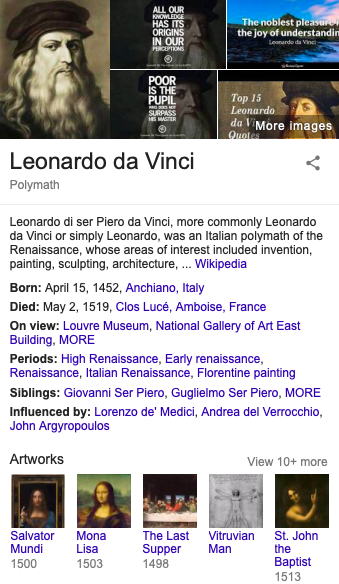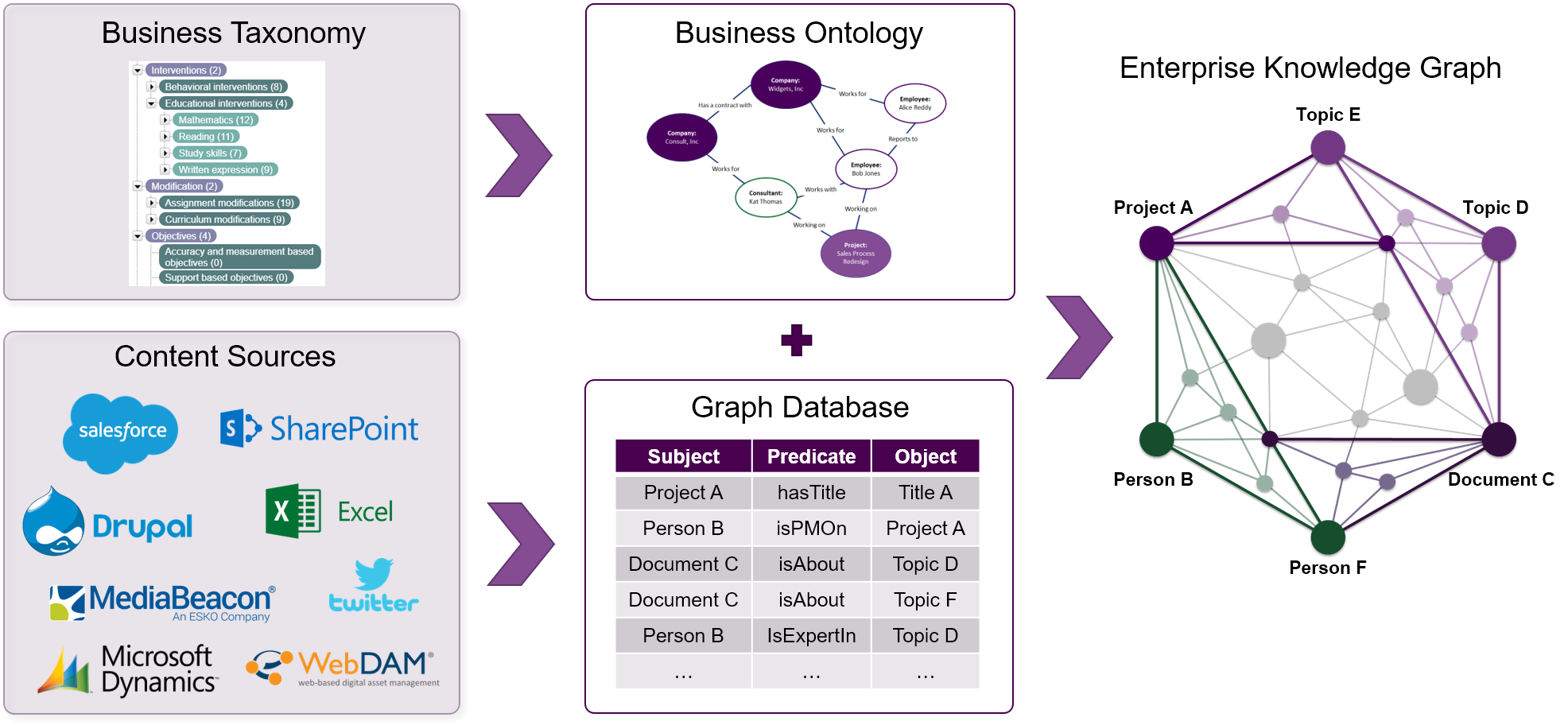Enterprise Knowledge Graphs have been on the rise. We see them as an incredibly valuable tool for relating your structured and unstructured information and discovering facts about your organization. Yet, knowledge graphs have been and still are far too underutilized. Organizations are still struggling to find and, more importantly, discover their valuable content. To take it a step further, knowledge graphs are a prerequisite for achieving smart, semantic artificial intelligence applications (AI) that can help you discover facts from your content, data, and organizational knowledge, which otherwise would go unnoticed. A smart semantic AI application, whether it is a chatbot, a cognitive search utilizing Natural Language Processing (NLP), or a recommendation engine, leverages your enterprise knowledge graph to extract, relate, and deliver answers, recommendations, and insights.
With semantic technologies, several terms have been thrown around, such as ontology, triple store, semantic data model, graph database, and knowledge graph. And that is before we even get into the standards like SKOS, RDF, OWL, etc. While it is easy to get into the details, for the purposes of this blog, I will focus on a high level overview of the components that make up an enterprise knowledge graph.
What is an Enterprise Knowledge Graph?
An enterprise knowledge graph is a representation of an organization’s knowledge domain and artifacts that is understood  by both humans and machines. It is a collection of references to your organization’s knowledge assets, content, and data that leverages a data model to describe the people, places, and things and how they are related. Some of the more prominent examples of knowledge graphs are of course Google’s implementation and LinkedIn. When you search for “Leonardo da Vinci” in Google, the search engine not only provides the traditional search results, but since it understands that you are searching for the specific person Leonardo da Vinci, it provides an info-box, or knowledge panel, along with the traditional search results with specific information about the unique person as well as his or her relationships to other known objects in the graph such as artworks, siblings, as well as recommendations about similar people. The image to the right shows this example from Google.
by both humans and machines. It is a collection of references to your organization’s knowledge assets, content, and data that leverages a data model to describe the people, places, and things and how they are related. Some of the more prominent examples of knowledge graphs are of course Google’s implementation and LinkedIn. When you search for “Leonardo da Vinci” in Google, the search engine not only provides the traditional search results, but since it understands that you are searching for the specific person Leonardo da Vinci, it provides an info-box, or knowledge panel, along with the traditional search results with specific information about the unique person as well as his or her relationships to other known objects in the graph such as artworks, siblings, as well as recommendations about similar people. The image to the right shows this example from Google.
In contrast, an enterprise knowledge graph is based on your organization’s content, data, and information assets and leverages a data model that is applicable to your industry or even specific to your organization.
There are several key elements that are necessary for developing a solid knowledge graph and the graphic below provides an overview of how they feed into each other to produce a comprehensive enterprise knowledge graph.
Key Components of an Enterprise Knowledge Graph
- Business taxonomy – While we have discussed business taxonomy in length, our “Taxonomy in 60 seconds” video provides a brief overview. For the purposes of this discussion, business taxonomy describes your organization’s vocabulary, common terms, and synonyms. This, then, serves as the basis for your organization to teach the machine your language.
- Business ontology – In a nutshell, an ontology is a semantic data model, a map that describes the various types of things we talk about in an organization like products, projects, and people; their properties, like name, description, and expertise; and the types of relationships between things. For example, a person can be a project manager for a project, or Project A is about Product B, or even Client C is interested in Service D and Service E. The key here is that the business taxonomy described above is a fundamental component in developing a relevant and applicable ontology. With an ontology, we transform strings into things, or metadata into objects with their own metadata (i.e. context!).
- Content and data sources – Every organization has a variety of data sources and systems each focused on specific areas like content and document management, databases for highly structured data, digital asset management, HR, learning and development, customer management, and others. The challenge is that the organizational knowledge lives in many, often disparate and siloed systems. Enter graph database.
- Graph database – Also known as a triple store, this database contains a comprehensive collection of references to your knowledge objects in their source systems, the properties for each object from the various sources, and the relationships between those objects.
Achieving data integration of structured and unstructured data sources into a graph database is a significant success in itself. However, to fully leverage the power behind semantic technologies and provide the context, meaning, and relationships that can be then leveraged by semantic AI applications, we need to combine the semantic data model, or ontology, with the data in the graph database. Applying the semantic data model on top of your integrated data produces a true semantically enriched enterprise knowledge graph.
Why Do I Want an Enterprise Knowledge Graph?
In short, an enterprise knowledge graph is a pillar to semantic AI. Knowledge graphs give AI applications intelligence. In other words, knowledge graphs provide the context, the meaning behind various concepts in your data. A knowledge graph helps the machine understand that a person is a person, and that a person can have specific attributes that other concepts do not possess, for example title, role on a project, expertise areas, date of birth, spoken languages, etc. Now, what if we can help the machine understand what a project is, what are some core properties that projects can have, like start and end date, focus area, product, client, project manager, and so on. To take it even further, knowledge graphs allow the machine to make inferences about your data, which are the basis of a relevant recommendation engine, predictive analytics, and other advanced AI applications.
Through these simple examples, we can now see the power behind teaching the machine the meaning behind our words, and the relationships between our various concepts.
In summary, some of the key benefits of enterprise knowledge graphs are:
- Enterprise knowledge graphs provide context behind your AI statistical algorithms to achieve the sought-after cognitive applications.
- Enterprise knowledge graphs help your AI discover hidden facts and relationships through inferences in your integrated content that you would otherwise be unable to catch on a large scale.
- Enterprise knowledge graphs help you identify all information you have in disparate data sources throughout your organization on a specific topic, about a specific person, project, product, claim, etc.
While enterprise knowledge graphs are on the rise, we still see organizations struggling to define and implement this highly valuable technology. If you are in the process of developing the business case for your enterprise knowledge graph or need assistance in implementing it, let us know. From strategy, to roadmap and implementation, learn more and contact us, we are here to help.

